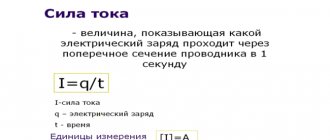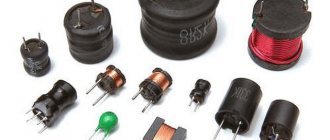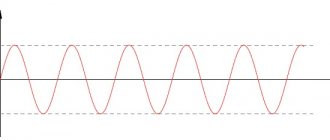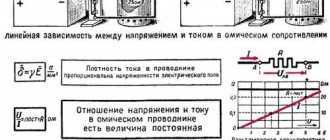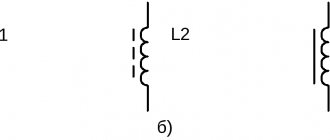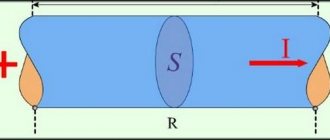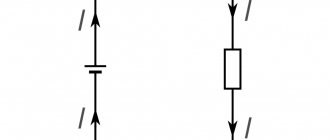Many people know that in addition to voltage, an electrical outlet also contains current, which is dangerous to human life. But how to measure it? How difficult is it to do? To measure current there is a special device called an ammeter.
So, an ammeter is an electrical measuring instrument designed to measure current in an electrical circuit. Electric current is the directional movement of charged particles (electrons), it is measured in Amperes and, accordingly, the device that measures it is called an ammeter.
An ideal ammeter has zero internal resistance. Well, where have you seen something ideal in our world? Therefore, even in a real ammeter, the internal resistance, although minimal, is still not zero. Like a voltmeter, an ammeter can also have a measurement range (for example, 1, 2, 3, 5, 10 A), which depends on the internal resistance of the electrical measuring instrument. As a rule, the additional resistance is already installed in the device body and is switched using a special switch.
Why is the ammeter always connected in series?
The ammeter ALWAYS connected to the electrical circuit being measured in series. All "directionally moving" electrons pass through the measuring device. But what about power losses, you ask? Yes, in this case it is inevitable, but it should be remembered that the ammeter has minimal internal resistance, and accordingly the power losses in it will be insignificant.
The ammeter resistance should be minimal for two reasons:
- All measured current passes through the ammeter.
- The ammeter should have minimal impact on the electrical circuit to which it is connected.
How to increase the measuring range of an ammeter?
In order to measure current as accurately as possible, we need to use an appropriate measuring range. An attempt to read values of several mA, when the scale covers measurements of up to 100 A, will end with us not even noticing the deviation of the ammeter needle.
Developers of ammeters use various technical solutions in order to be able to measure current in different ranges. In some cases, we can change the measuring range of the device ourselves. If we add an additional resistor to it (the so-called shunt), as shown in Fig. 6, we will be able to measure higher currents without subjecting the fragile structure of the ammeter to destruction.
Rice. 6. Extending the range of the magnetoelectric ammeter by adding a shunt resistor
Suppose we want to increase the ammeter's measuring range by n times . The total current I flowing through the device (Fig. 6) is then equal to n*IA . Then the equations of Kirchhoff’s first and second rules will be as follows:
- n ⋅ IA = IA + IB
- IB ⋅ RB = IA ⋅ RA
Therefore, the resistance of the shunt resistor can be calculated as follows:
RB = RA / (n-1)
For design reasons, the shunt resistor is used only for the magnetoelectric ammeter.
Types of ammeters
The classification of ammeters depends on their design and the type of current flowing through it. Below are the types of electrical measuring instruments with respect to design.
- Ammeter of magnetoelectric system with permanent magnet.
- Electromagnetic ammeter.
- Electrodynamic ammeter.
- Ammeter with bridge rectifier.
According to the type of current, ammeters are divided into:
- DC ammeters;
- AC ammeters;
Permanent magnet moving coil (PMMC) magnetoelectric ammeter
The magnetoelectric principle underlies the operation of such a device. In short, the essence of its work is as follows: the coil of the measuring device is placed in a constant magnetic field. When current flows through the coil, a torque will be created, which will turn the arrow of the device.
Electrodynamic ammeter
It is used to measure both AC and DC current. The accuracy of the device is quite high compared to a magnetoelectric measuring device. The calibration of the device is the same for both alternating and direct current, that is, if the ammeter was calibrated for direct current, then it can be used to measure alternating current without recalibration.
Detector system ammeter (with bridge rectifier)
Used to measure alternating current. The devices use a bridge rectifier that converts alternating current into direct current, which is measured using a magnetoelectric ammeter. This type of device is used to measure current in control circuits and when using current transformers.
Measuring shunt
Excessive currents that can flow in powerful power circuits will damage the measuring device when connected directly. To avoid this, use a measuring shunt.
The shunt has a very low active resistance, which has minimal effect on the measured circuit. In parallel, an ammeter is connected to it, which already measures the current.
Ammeter-voltmeter method
The ammeter-voltmeter method is one of the simplest, but also less accurate measurement methods and can be used in DC and AC circuits. To implement this method, ammeters and voltmeters of the magnetoelectric system are used in direct current circuits, devices of the electromagnetic and electrodynamic systems are used in alternating current circuits of industrial frequencies, and devices of the thermoelectric system are used in circuits powered by sound and high frequencies. In all cases of use, high-precision instruments provide less measurement error.
The ammeter-voltmeter method is indirect, since it is based on the use of Ohm's law, according to which the measured resistance is directly proportional to the voltage drop across it and inversely proportional to the current flowing through it.
Resistor resistance measurement
is carried out according to one of the schemes shown in Fig. 4.1.
Rice. 4.1. Schemes for measuring the resistance of resistors when measuring using the A-V method (a)
and the V-A method (
6
)
For the first scheme (see Fig. 4.1, a)
the required resistance
Rx
is found by the formula
(4.1)
where R
c
is the internal
resistance of the voltmeter.
For the second circuit (see Fig. 4.1. b) the measured resistance Rx
determined by the formula
(4.2)
where R
A is the internal resistance of the ammeter.
When using both schemes, there is a methodological error due to the devices’ own power consumption (Fig. 4.2).
From the analysis of formulas (4.1) and (4.2), as well as from the dependence graphs (see Fig. 4.2), it follows that the ammeter-voltmeter (A-V) method must be used when measuring low resistances of resistors, when Rx
<<
R
B, and the voltmeter-ammeter method (V-A) - when measuring high resistances, when
Rx
<<
R
A
.
The error of both methods is quite large (1.5...2%) and directly depends on the stability of the power source voltage and on the accuracy class of the devices used.
| Rice. 4.2. Graph of the dependence of the measurement error on the resistance of the resistor when measuring using the A-V and V-A methods |
Measuring the capacitance of capacitors
is also possible using the V-A and A-V methods.
To power the circuits, only an AC voltage source is used, since in DC circuits the reactance xL of the inductor will be zero, and the reactance xC of
the capacitor tends to infinity. These statements are based on known dependencies:
x L=2πFL
;
xC=
1
/
2
πFC.
Measuring the capacitance of capacitors is carried out according to one of the schemes shown in Fig. 4.3.
Rice. 4.3. Scheme for measuring capacitance of capacitors using the A-V method ( a
) and the VA method
(b)
If we neglect the influence of the capacitor leakage resistance, then
where
(4.3)
From formula (4.3) it follows that when measuring the capacitance of capacitors, it is necessary to know the frequency of the circuit’s power source.
Depending on the capacitance value of the capacitor being measured, you can reduce the influence of the internal resistance of the voltmeter on the measurement result using the first circuit (see Fig. 4.3 . a),
and for high-capacity capacitors - the second circuit (see Fig. 4.3,
b).
Coil inductance measurement
is performed using the V-A method with the ratio R
L
<<х L
(
the active resistance of the coil should be significantly less than its reactance). Figure 4.4 shows a diagram for measuring the inductance of coils.
Based on Ohm's law
Where
(4.4)
The measurement of inductance at low frequencies will be approximate, since the active resistance of the RL coil is not taken into account,
and at high frequencies the measurement error is due to the influence of the coil’s own capacitance
CL
and the input capacitance CB of the voltmeter, which, as is known, adds up to
CL
:
Commun = CL + CB.
As a result, a parallel oscillatory circuit with its own frequency of oscillation is formed:
As the frequency of the circuit's power supply approaches f
The resistance of the circuit increases, which corresponds to an increase in the inductance of the coil
L.
The V-A (A-V) method is implemented using widely used devices under conditions corresponding to the operating mode of the circuit elements. The disadvantages of the method include its indirectness, labor-intensive measurements, large measurement error (units of percent), and limited range of parameter measurements. Due to such significant shortcomings, this method is not widely used.
| Rice. 4.5. Schematic diagram of an electronic ohmmeter |
The best results when measuring the resistance of resistors are shown by electronic ohmmeters
(E6), which are made on the basis of a UPT covered by negative feedback and having a very high input resistance (Fig. 4.5).
Ohmmeter amplifier output voltage
(4.5)
where kU -
gain factor of the UPT without a feedback circuit;
β is the feedback transfer coefficient:
With a large gain kU,
product(
kU •
β)
>>
1 and output voltage
(4.6)
As a result, the scale of the analog device is uniform and practically independent of external elements connected to the amplifier. The measurement error of analog ohmmeters is large - approximately 1...4%.
In teraohmmeters
resistors
R
1 and
Rx
are swapped and the scale of the analog indicator becomes reversed (scale zero is on the right).
(4.7)
The measurement error of teraohmmeters reaches 10%.
The advantages of electronic ohmmeters include direct reading and a wide range of measuring resistor resistance.
The ammeter-voltmeter method is one of the simplest, but also less accurate measurement methods and can be used in DC and AC circuits. To implement this method, ammeters and voltmeters of the magnetoelectric system are used in direct current circuits, devices of the electromagnetic and electrodynamic systems are used in alternating current circuits of industrial frequencies, and devices of the thermoelectric system are used in circuits powered by sound and high frequencies. In all cases of use, high-precision instruments provide less measurement error.
The ammeter-voltmeter method is indirect, since it is based on the use of Ohm's law, according to which the measured resistance is directly proportional to the voltage drop across it and inversely proportional to the current flowing through it.
Resistor resistance measurement
is carried out according to one of the schemes shown in Fig. 4.1.
Rice. 4.1. Schemes for measuring the resistance of resistors when measuring using the A-V method (a)
and the V-A method (
6
)
For the first scheme (see Fig. 4.1, a)
the required resistance
Rx
is found by the formula
(4.1)
where R
c
is the internal
resistance of the voltmeter.
For the second circuit (see Fig. 4.1. b) the measured resistance Rx
determined by the formula
(4.2)
where R
A is the internal resistance of the ammeter.
When using both schemes, there is a methodological error due to the devices’ own power consumption (Fig. 4.2).
From the analysis of formulas (4.1) and (4.2), as well as from the dependence graphs (see Fig. 4.2), it follows that the ammeter-voltmeter (A-V) method must be used when measuring low resistances of resistors, when Rx
<<
R
B, and the voltmeter-ammeter method (V-A) - when measuring high resistances, when
Rx
<<
R
A
.
The error of both methods is quite large (1.5...2%) and directly depends on the stability of the power source voltage and on the accuracy class of the devices used.
| Rice. 4.2. Graph of the dependence of the measurement error on the resistance of the resistor when measuring using the A-V and V-A methods |
Measuring the capacitance of capacitors
is also possible using the V-A and A-V methods.
To power the circuits, only an AC voltage source is used, since in DC circuits the reactance xL of the inductor will be zero, and the reactance xC of
the capacitor tends to infinity. These statements are based on known dependencies:
x L=2πFL
;
xC=
1
/
2
πFC.
Measuring the capacitance of capacitors is carried out according to one of the schemes shown in Fig. 4.3.
Rice. 4.3. Scheme for measuring capacitance of capacitors using the A-V method ( a
) and the VA method
(b)
If we neglect the influence of the capacitor leakage resistance, then
where
(4.3)
From formula (4.3) it follows that when measuring the capacitance of capacitors, it is necessary to know the frequency of the circuit’s power source.
Depending on the capacitance value of the capacitor being measured, you can reduce the influence of the internal resistance of the voltmeter on the measurement result using the first circuit (see Fig. 4.3 . a),
and for high-capacity capacitors - the second circuit (see Fig. 4.3,
b).
Coil inductance measurement
is performed using the V-A method with the ratio R
L
<<х L
(
the active resistance of the coil should be significantly less than its reactance). Figure 4.4 shows a diagram for measuring the inductance of coils.
Based on Ohm's law
Where
(4.4)
The measurement of inductance at low frequencies will be approximate, since the active resistance of the RL coil is not taken into account,
and at high frequencies the measurement error is due to the influence of the coil’s own capacitance
CL
and the input capacitance CB of the voltmeter, which, as is known, adds up to
CL
:
Commun = CL + CB.
As a result, a parallel oscillatory circuit with its own frequency of oscillation is formed:
As the frequency of the circuit's power supply approaches f
The resistance of the circuit increases, which corresponds to an increase in the inductance of the coil
L.
The V-A (A-V) method is implemented using widely used devices under conditions corresponding to the operating mode of the circuit elements. The disadvantages of the method include its indirectness, labor-intensive measurements, large measurement error (units of percent), and limited range of parameter measurements. Due to such significant shortcomings, this method is not widely used.
| Rice. 4.5. Schematic diagram of an electronic ohmmeter |
The best results when measuring the resistance of resistors are shown by electronic ohmmeters
(E6), which are made on the basis of a UPT covered by negative feedback and having a very high input resistance (Fig. 4.5).
Ohmmeter amplifier output voltage
(4.5)
where kU -
gain factor of the UPT without a feedback circuit;
β is the feedback transfer coefficient:
With a large gain kU,
product(
kU •
β)
>>
1 and output voltage
(4.6)
As a result, the scale of the analog device is uniform and practically independent of external elements connected to the amplifier. The measurement error of analog ohmmeters is large - approximately 1...4%.
In teraohmmeters
resistors
R
1 and
Rx
are swapped and the scale of the analog indicator becomes reversed (scale zero is on the right).
(4.7)
The measurement error of teraohmmeters reaches 10%.
The advantages of electronic ohmmeters include direct reading and a wide range of measuring resistor resistance.
Effect of temperature on current measurement
The ammeter is a sensitive device that is significantly affected by ambient temperature. Changing the temperature causes an error in the readings. You can use additional resistance (ballast resistance). Resistance with zero temperature coefficient is called additional resistance (swamping resistance). It is connected in series with the coil of the electrical measuring instrument. Ballast resistance reduces the influence of temperature on the instrument readings.
The ammeter has a built-in fuse that protects it from current surges (incorrect connection). If significant current flows through the ammeter, the fuse will blow, thereby breaking the electrical circuit and preserving the instrument's measuring system. Accordingly, the device cannot be used until the fuse link is replaced.
Expanding the measurement limits of ammeters and voltmeters
To obtain high accuracy and sensitivity of magnetoelectric devices, their moving windings are made as light as possible from very thin insulated wire.
Such windings allow very small currents, not exceeding 30 mA, while the resistance of the windings themselves is approximately 5 Ohms.
Thus, a magnetoelectric device can measure current no more than 30 mA, and voltage no higher than 150 mV, since
U = I × R = 30 × 5 = 150 mV
To expand the measurement limits of the ammeter, shunts are used; the shunts have a very low resistance (tenths, hundredths of an ohm) and are connected in parallel with the ammeter winding. The size of the shunt RШ is determined by the formula:
where RШ is the shunt resistance;
RA – ammeter resistance;
n is the coefficient of expansion of the current measurement limits with an ammeter.
where I is the measured current;
IA – maximum permissible current of the ammeter.
To expand the measurement limits of voltmeters, additional resistances are used, which have a high resistance (tens of kilo-ohms) and are connected in series with the voltmeter winding. The amount of additional resistance RD is determined by the formula:
where RD is additional resistance;
RV – voltmeter resistance;
n – coefficient of expansion of the voltage measurement limits with a voltmeter.
where U is the measured voltage;
UV is the maximum permissible voltage of the voltmeter.
Source: vitta201.jimdo.com

